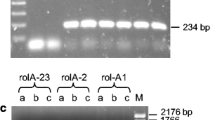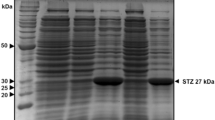Abstract
It has been reported that rol plant oncogenes located in Ri-plasmids of Agrobacterium rhizogenes activated synthesis of secondary metabolites in the transformed plant cells. The activator mechanism is still unknown. In this work, we studied whether the NADPH oxidase-signaling pathway, which regulates the synthesis of defense metabolites in plants, is involved in the activator function of the rol genes. It was demonstrated that the transformation of Rubia cordifolia cells by the rolB and rolC genes caused an induction of biosynthesis of anthraquinone-type phytoalexins. Inhibition studies revealed a striking difference between the rolC and rolB transformed cultures in their sensitivity to Ca2+ channel blockers and calcium deficiency. The rolC culture displayed lowered resistance to the inhibitors compared to the non-transformed culture, while the rolB culture was more resistant to the treatment. The assumption was made that the oncogenic potential of rol genes is realized through the alteration of calcium balance in the plant cells. Anthraquinone production was not inhibited in the non-transformed and transformed cultures by Ca2+ channel blockers, as well as by diphenylene iodonium, an inhibitor of NADPH oxidase, and by the protein kinase inhibitor staurosporine. These results indicate that the induction of anthraquinone production in transgenic cultures does not involve the activation of Ca2+-dependent NADPH oxidase pathway.
Similar content being viewed by others
REFERENCES
Spena, A., Schmulling, T., Koncz, C., and Schell, J. S. (1987) EMBO J., 6, 3891-3899.
Bulgakov, V. P., Khodakovskaya, M. V., Labetskaya, N. V., Tchernoded, G. K., and Zhuravlev, Y. N. (1998) Phytochemistry, 49, 1929-1934.
Palazon, J., Cusido, R. M., Gonzalo, J., Bonfill, M., Morales, S., and Pinol, M. T. (1998) J. Plant. Physiol., 153, 712-718.
Bonhomme, V., Laurain Mattar, D., and Fliniaux, M. A. (2000) J. Natur. Prod., 63, 1249-1252.
Estruch, J. J., Schell, J., and Spena, A. (1991) EMBO J., 10, 3125-3128.
Estruch, J. J., Chriqui, D., Grossmann, K., Schell, J., and Spena, A. (1991) EMBO J., 10, 2889-2895.
Delbarre, A., Muller, P., Imhoff, V., Barbier-Brygoo, H., Maurel, C., Leblanc, N., Perrot-Rechenmann, C., and Guern, J. (1994) Plant Physiol., 105, 563-569.
Nilsson, O., Moritz, T., Sundberg, B., Sandberg, G., and Olsson, O. (1996) Plant Physiol., 112, 493-502.
Faiss, M., Strnad, M., Redig, P., Dolezal, K., Hanus, J., van Onckelen, H., and Schmulling, T. (1996) Plant J., 10, 33-46.
Philippini, F., Rossi, V., Marin, O., Trovato, M., Costantino, P., Downey, P. M., Schiavo, F., and Terzi, M. (1996) Nature, 379, 499-500.
Baumann, K., de Paolis, A., Costantino, P., and Gualberti, G. (1999) Plant Cell, 11, 323-333.
Xing, T., Higgins, V. J., and Blumwald, E. (1997) Plant Cell, 9, 249-259.
Romeis, T., Piedras, P., and Jones, J. D. G. (2000) Plant Cell, 12, 803-815.
Jabs, T., Tschope, M., Colling, C., Hahlbrock, K., and Scheel, D. (1997) Proc. Natl. Acad. Sci. USA, 94, 4800-4805.
Xing, T., Wang, X.-J., Malik, K., and Miki, B. L. (2001) Mol. Plant–Microbe Interact., 14, 1261-1264.
Kovtun, Y., Chiu, W.-L., and Sheen, J. (2000) Proc. Natl. Acad. Sci. USA, 97, 2940-2945.
Ono, E., Wong, H. L., Kawasaki, T., Hasegawa, M., Kodama, O., and Shimamoto, K. (2001) Proc. Natl. Acad. Sci. USA, 98, 759-764.
Hirschi, K. D. (1999) Plant Cell, 11, 2113-2122.
Blechert, S., Brodschelm, W., Holder, S., Kammerer, L., Kutchan, T. M., Mueller, M. J., Xia, Z.-Q., and Zenk, M. H. (1995) Proc. Natl. Acad. Sci. USA, 92, 4099-4105.
Cho, G. H., Kim, D. I., Pedersen, H., and Chin, C.-K. (1988) Biotechnol. Progr., 4, 184-188.
Bulgakov, V. P., Tchernoded, G. K., Mischenko, N. P., Khodakovskaya, M. V., Glazunov, V. P., Zvereva, E. V., Fedoreyev, S. A., and Zhuravlev, Y. N. (2002) J. Biotechnol., 97, 213-221.
Mischenko, N. P., Fedoreyev, S. A., Glazunov, V. P., Tchernoded, G. K., Bulgakov, V. P., and Zhuravlev, Y. N. (1999) Fitoterapia, 70, 552-557.
Pineros, M., and Tester, M. (1997) J. Membr. Biol., 157, 139-145.
Menke, F. L. H., Parchmann, S., Mueller, M. J., Kijne, J. W., and Memelink, J. (1999) Plant Physiol., 119, 1289-1296.
Xing, T., Malik, K., Martin, T., and Miki, B. L. (2001) Plant Mol. Biol., 46, 109-120.
Guo, Z.-J., Lamb, C., and Dixon, R. A. (1998) Plant Physiol., 118, 1487-1494.
Olivari, C., Albumi, C., Pugliarello, C. M., and Michelis, M. I. D. (2000) Plant Physiol., 122, 463-470.
Pafford, C. M., Simples, J. E., and Strong, J. A. (1995) Cell Calcium, 18, 400-410.
Arnoult, C., Lemos, J. R., and Florman, H. M. (1997) EMBO J., 16, 1593-1599.
Roder, F. T., Schmulling, T., and Gatz, C. (1994) Mol. Gen. Genet., 243, 32-38.
Capone, I., Spano, L., Cardarelli, M., Bellincampi, D., Petit, A., and Costantino, P. (1989) Plant Mol. Biol., 13, 43-52.
Sasabe, M., Takeuchi, K., Kamoun, S., Ichinose, Y., Govers, F., Toyoda, K., Shiraishi, T., and Yamada, T. (2000) Eur. J. Biochem., 267, 5005-5013.
Author information
Authors and Affiliations
Rights and permissions
About this article
Cite this article
Bulgakov, V.P., Tchernoded, G.K., Mischenko, N.P. et al. Increase in Anthraquinone Content in Rubia cordifolia Cells Transformed by rol Genes Does Not Involve Activation of the NADPH Oxidase Signaling Pathway. Biochemistry (Moscow) 68, 795–801 (2003). https://doi.org/10.1023/A:1025091118544
Issue Date:
DOI: https://doi.org/10.1023/A:1025091118544




